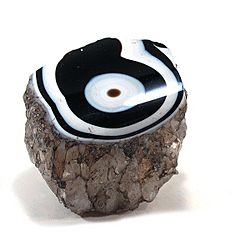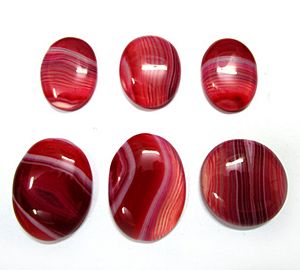Onyx facts for kids
Quick facts for kids Onyx |
|
|---|---|
 |
|
| General | |
| Category | Oxide mineral |
| Formula (repeating unit) |
Silica (silicon dioxide, SiO2) |
| Identification | |
| Formula mass | 60 g / mol |
| Color | Various |
| Crystal system | Trigonal |
| Cleavage | no cleavage |
| Fracture | Uneven, conchoidal |
| Mohs scale hardness | 6.5–7 |
| Luster | Vitreous, silky |
| Streak | White |
| Diaphaneity | Translucent |
| Specific gravity | 2.55–2.70 |
| Optical properties | Uniaxial/+ |
| Refractive index | 1.530 to 1.543 |
Onyx is a type of chalcedony, which is a silicate mineral. It is special because it has straight, parallel bands of different colors. Think of it like a layered cake, but with straight lines instead of swirly ones.
Another similar stone is agate. Agate also has layers, but its bands are usually curved. Onyx and agate are both made of chalcedony.
Onyx can come in many colors. Its bands can be white, black, or almost any other color. Often, you will see onyx with bands of black and white. Sometimes, the word "onyx" is also used for other layered materials. These can include alabaster, marble, obsidian, or opal.
Contents
What is Onyx Made Of?
Onyx is made of bands of chalcedony that have different colors. It is a cryptocrystalline stone. This means its crystals are so tiny you need a microscope to see them. It is made of very fine bits of quartz and moganite.
The bands in onyx are always parallel to each other. This is different from agate, which often has swirly or chaotic bands.
Sardonyx: A Special Type of Onyx
Sardonyx is a type of onyx where the colored bands are red or reddish-brown. This color is called "sard." Instead of black bands, sardonyx has these reddish layers.
Black onyx is very well-known. However, it is not as common as onyx with other colored bands. People have used special treatments for a very long time to make black onyx truly black. They also use treatments to create the red and yellow colors in sardonyx. Most black onyx you see today has been colored artificially.
Fake Onyx and How It's Treated
Sometimes, other banded materials are called "onyx." For example, banded calcite found in places like Mexico and India is often carved and sold as "onyx." This material is much softer than real onyx. It is also much easier to find. Most carved items sold as "onyx" today are actually this calcite material.
People have also made artificial onyx from regular chalcedony and plain agates. The ancient Romans used these methods. A writer named Pliny the Elder described these techniques in the first century.
To make black onyx, people would soak or boil chalcedony in sugar water. Then, they would treat it with sulfuric acid or hydrochloric acid. This acid would turn the sugar that soaked into the stone's top layers into carbon, making it black. These old methods are still used today. Other dyeing methods are also common. Most "black onyx" sold today has been treated artificially. Heating and using nitric acid can also lighten or remove colors that are not wanted.
Where is Onyx Found?
Onyx is a gemstone found in many parts of the world. Some of these places include:
- Yemen
- Uruguay
- Argentina
- Australia
- Brazil
- Canada
- China
- Czech Republic
- Germany
- India
- Indonesia
- Madagascar
- UK
- Various states in the US
How Onyx Has Been Used Through History

Onyx has been used for a very long time. People have carved it into beautiful objects and used it in jewelry. It is often cut into a smooth, rounded shape called a cabochon. It is also made into beads.
Onyx is also used for special carvings called intaglio and cameos. In these carvings, the different colored bands of the onyx make the image stand out. Some onyx is natural, but much of what is sold has been colored by staining agate.
The ancient Egyptians used onyx as early as 2686 BC. They made bowls and other pottery items from it. Sardonyx was used in the art of the Minoan civilization on the island of Crete.
In the 1920s and 1930s, Brazilian green onyx was popular. It was often used as bases for Art Deco sculptures. A German sculptor named Ferdinand Preiss used green onyx for most of his sculptures. Green onyx was also made into trays and dishes, especially in Austria. These often had small bronze animals or figures on them.
Onyx is mentioned many times in the Bible. Sardonyx, which has white layers mixed with red "sard" layers, is also mentioned.
The Ancient Greeks and Romans knew about onyx. Pliny the Elder, a Roman writer, described different types of onyx. He also wrote about how people treated the stone to change its colors.
In 1930, architect Ludwig Mies van der Rohe used large slabs of onyx in the Villa Tugendhat in Brno. These slabs came from the Atlas Mountains. They created a beautiful, glowing wall inside the house.
The Hôtel de la Païva in Paris is famous for its yellow onyx decorations. The new Mariinsky Theatre Second Stage in St. Petersburg also uses yellow onyx in its lobby.
Old Beliefs About Onyx
The ancient Romans believed that sardonyx could give them courage. They would carry amulets of sardonyx carved with Mars, their god of war, when they went into battle. In Europe during the Renaissance (a period from the 14th to the 17th century), people thought wearing sardonyx would help them speak well.
Related pages
Images for kids
See also
 In Spanish: Ónix para niños
In Spanish: Ónix para niños




